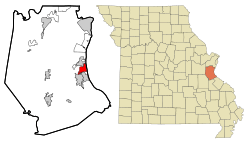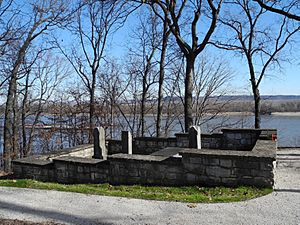Herculaneum, Missouri facts for kids
Quick facts for kids
Herculaneum, Missouri
|
|
|---|---|
| Nickname(s):
Herky
|
|

Location of Herculaneum, Missouri
|
|
| Country | United States |
| State | Missouri |
| County | Jefferson |
| Incorporated | July 27, 1819 (April 1972) |
| Government | |
| • Type | Mayor and Board of Aldermen |
| Area | |
| • Total | 4.19 sq mi (10.84 km2) |
| • Land | 4.16 sq mi (10.77 km2) |
| • Water | 0.03 sq mi (0.08 km2) |
| Elevation | 440 ft (130 m) |
| Population
(2020)
|
|
| • Total | 4,672 |
| • Density | 1,123.62/sq mi (433.85/km2) |
| Time zone | UTC-6 (Central (CST)) |
| • Summer (DST) | UTC-5 (CDT) |
| ZIP code |
63048
|
| Area code(s) | 636 |
| FIPS code | 29-31708 |
| GNIS feature ID | 2394358 |
| Website | cityofherculaneum.org |
Herculaneum is a city in Jefferson County, Missouri. It is a suburb of St. Louis. In 2020, about 4,672 people lived there. Herculaneum was the first county seat of Jefferson County from 1819 to 1839. The city celebrated its 200th birthday in 2008.
Herculaneum has been named a "Tree City USA" by the Arbor Day Foundation for many years. It is also the honorary hometown of the 40th Airlift Squadron, known as "The Screaming Eagles," from Dyess Air Force Base in Texas.
Contents
- Geography and Location
- How Herculaneum Started
- Herculaneum's History
- Environmental Care
- Population Information
- Churches and Places of Worship
- Cemeteries
- Education in Herculaneum
- Fire Department Services
- Police Department Services
- City Parks and Recreation
- Fun Attractions
- Famous People from Herculaneum
- Images for kids
- See also
Geography and Location
Herculaneum is located in Missouri. The city covers about 4.10 square miles (10.62 square kilometers). Most of this area is land, with a small part being water.
How Herculaneum Started
Herculaneum was founded in 1808 by Moses Austin and Samuel Hammond. They chose this spot on the Mississippi River because it was a good place to ship lead from Austin's mines in Potosi. It was closer than another town called Ste. Genevieve.
The town got its name from the ancient Roman city of Herculaneum. This Roman city was destroyed by the volcano Mount Vesuvius. Moses Austin thought the limestone cliffs overlooking the Mississippi River looked like a Roman amphitheatre.
Early on, tall structures called Shot towers were built next to the bluffs. These towers made lead ammunition. Lead cannonballs from Herculaneum were even used in the War of 1812. For a long time, lead smelting was a major industry here. The Doe Run Company used to operate a large lead smelter. However, it closed down because it could not meet new environmental rules.
Herculaneum's History
In 1798, Moses Austin, who came from Connecticut, received land from Spain. He learned about the rich mineral deposits, especially lead. He brought equipment and workers to start mining and smelting lead. In 1808, Austin and Samuel Hammond planned the town at the mouth of Joachim Creek. The town's main purpose was to be a shipping point for lead.
Herculaneum had the first post office in Jefferson County. It was the only one for almost 30 years. By 1813, three shot towers were built on the bluffs. These towers made round lead pellets for firearms. They did this by dropping melted lead through sieves into a water basin.
In 1818, Jefferson County was formed. In 1819, Herculaneum became the county seat. At that time, Herculaneum had about 30 to 40 homes, stores, a post office, a jail, a court, and a school. The town's importance decreased when the county seat moved to Hillsboro in 1839. Also, a railway bypassed the town in the 1850s.
The town began to grow again in 1887. The St. Joseph Lead Company chose Herculaneum for a lead smelting site. A railroad, the Mississippi River & Bonne Terre Railroad, also built tracks into the town. The smelter began operating in 1892. It became the largest lead smelter in the United States. It produced a lot of refined lead each year. The Doe Run Company bought the operations in 1981.
In 1970, people worked to officially reactivate Herculaneum's city status. It was found that the city had been incorporated way back in 1819. On January 7, 1972, the court officially recognized Herculaneum as a functioning city. An election was held in April 1972 to choose a board of trustees. The first mayor and board of aldermen were elected in April 1973.
In 2013, the Doe Run Company announced it would close its smelter. This was due to the rising costs of meeting environmental rules. The closure marked the end of a long era of lead production in the region. The demolition of the Doe Run Company buildings happened in 2018.
Environmental Care
For many years, Herculaneum faced challenges with lead in its soil and groundwater. This was due to the Doe Run plant's lead smelter. Trucks carrying lead materials sometimes caused lead dust to settle on roads.
In 2001, officials found high levels of lead dust on the roads. In 2010, the Doe Run Company reached an agreement with the EPA. They worked to clean up the area and improve environmental safety. At the end of 2013, the smelter operations in Herculaneum closed. However, other related activities continued.
Population Information
| Historical population | |||
|---|---|---|---|
| Census | Pop. | %± | |
| 1950 | 1,603 | — | |
| 1960 | 1,767 | 10.2% | |
| 1970 | 2,439 | 38.0% | |
| 1980 | 2,293 | −6.0% | |
| 1990 | 2,263 | −1.3% | |
| 2000 | 2,805 | 24.0% | |
| 2010 | 3,468 | 23.6% | |
| 2020 | 4,672 | 34.7% | |
| U.S. Decennial Census | |||
In 2010, Herculaneum had 3,468 people living in 1,309 households. Most residents were White (95.4%). The average age in the city was 37.8 years old. About 23.9% of residents were under 18.
Churches and Places of Worship
Herculaneum has several churches. These include Buren Chapel AME, United Methodist Church, Assembly of God Church, Journey Community Church, Heart of the Apostles Fellowship, and the Church of Jesus Christ of Latter-Day Saints.
A very early Protestant service took place near Herculaneum in 1793. A Methodist minister preached from a boat on the Mississippi River.
Cemeteries
Herculaneum has several cemeteries. These include the Herculaneum City Cemetery, Assumption Catholic Cemetery, Rankin Memorial Cemetery, and the Daniel Dunklin family gravesite. There are also a few smaller family cemeteries.
Education in Herculaneum
The Dunklin R-5 School District serves Herculaneum, Pevely, and Horine. Its main offices are in Herculaneum. Herculaneum High School and Senn-Thomas Middle School (grades 6-8) are both in the city. Pevely Elementary School (grades K-5) is in Pevely.
The original Herculaneum Public School was built in 1912. It housed all grades until a fire in 1947. After repairs, it reopened as Herculaneum High School in 1949. A new high school building opened in 2011 on the same spot. A special feature of the high school is its stone bleachers at the football field. These were built as a Works Progress Administration (WPA) project in 1935-1936.
The Roy E. Taylor Elementary building is now used as an Early Childhood Learning Center. Herculaneum also had a Douglass Elementary School, which closed in 1957.
Fire Department Services
The Herculaneum Volunteer Fire Department started in 1951. It provides fire protection to most of the city. The department operates from one fire station. It has 16 volunteers and one paid firefighter. They respond to fire, rescue, and EMS calls. Their equipment includes pumper trucks, rescue vehicles, and water rescue boats.
Police Department Services
The City of Herculaneum has its own police department. The Herculaneum Police Department Office is located in the basement of Herculaneum City Hall. The police are dispatched through Jefferson County 911 Dispatch. The current Chief of Police is Sharia Kyle.
City Parks and Recreation
Herculaneum has several parks for residents to enjoy.
Kade's Playground
Kade's Playground is a special volcano-themed playground. It is designed to be fun for all kids, including those with disabilities. It opened in 2015 in Herculaneum City Park. The Bay of Naples Splash Zone, a water play area, opened next to it in 2019.
Herculaneum City Park
This is the largest park in Herculaneum. It has three baseball fields, the Joachim Loop Trail, and the All Bark Village Dog Park. The universally accessible Kade's Playground is also here. The park hosts many events, like "Movies in the Park," the Jeffco Fire Engine Rally, Easter egg hunts, and the city's Fourth of July Celebration.
Bates Memorial Park
Located on both sides of Joachim Creek, this park is named after Judge Nicholas Bates. It has a boat ramp, a pavilion, and fishing areas. Part of the Joachim Loop Trail also runs through it.
Dunklin-Fletcher Memorial Park
This park is on North Main Street and overlooks the Mississippi River. It honors two Missouri Governors: Daniel Dunklin and Thomas C. Fletcher. It offers great views of the river and has benches and picnic tables.
Shot Tower Memorial Park
This park was dedicated in 2003. It remembers the three shot towers that were in Herculaneum in the early 1800s. The park has sidewalks lined with special bricks celebrating the town's history. It also has a bronze plaque about the Maclot Shot Tower, which was the first shot tower west of Pittsburgh.
Governor Daniel Dunklin State Park
This park is at the end of Dunklin Drive and overlooks the Mississippi River. It contains the graves of Governor Dunklin and his family. It is the smallest state park in Missouri. It is also a state historic site. The gravesite was improved in 2011-2012 to make it easier to access.
Fun Attractions
Herculaneum offers a few interesting places to visit.
Joachim Golf Course
This golf course was built in 1934. It is a nine-hole course with different tee boxes for all skill levels. It is known for some challenging holes with sand bunkers and ponds.
Governor Daniel Dunklin's Gravesite
The gravesite of Daniel Dunklin is located at the end of Dunklin Drive. He was the 5th Governor of Missouri. He died in Herculaneum and is buried here with his family. This gravesite is the smallest state park in Missouri and is a State Historic Site.
Mississippi River Access
Herculaneum is right next to the Mississippi River. You can see the river from the Daniel Dunklin Grave Site and Dunklin-Fletcher Memorial Park. You can also get to the river by Ferry Road.
Famous People from Herculaneum
- Rick Burchett (born 1952) - a comic book artist known for his work on Batman and Superman.
- Daniel Dunklin (died 1844) - the 5th Governor of Missouri; he died and is buried in Herculaneum.
- Thomas Clement Fletcher (born 1827) - the 18th Governor of Missouri; he was born in Herculaneum.
- Campbell Morfit (born 1820) - a chemist.
- Tony Stevens (1948-2011) - a choreographer, dancer, and director who helped create the story of A Chorus Line.
Images for kids
-
Depiction in mural at Missouri State Capitol
See also
 In Spanish: Herculaneum (Misuri) para niños
In Spanish: Herculaneum (Misuri) para niños




